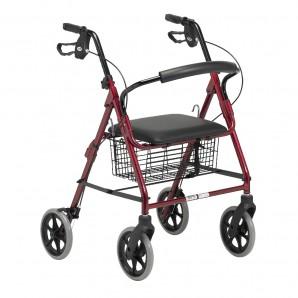With obesity on the rise in the United Kingdom, bariatric care is becoming increasingly relevant in modern society. More people than ever are carrying excessive weight. 2019 figures from the NHS reveal that 29% of adults in the UK are obese. Of that percentage, a smaller number are severely obesity. This means reduced mobility, leading many turning to disability aids in order to move around independently.
Bariatric Walking Aids
A rollator walker is important equipment for many people who may find it hard to walk because of their weight. Excessive fat puts strain on the body, making it difficult to move even short distances. Not only is weight a factor, but also the greater body mass inhibits the person’s range of motion.
A wheeled walking aid like this offers more support than a stick. It allows both arms and shoulders to take the user’s weight at the same time.
A typical rollator has either three or four wheels and acts as a robust support frame, suitable for outdoor use. For severely overweight people, four wheeled models are better, mainly because of their stability. A wheel in each corner spreads the weight evenly, making the walker less likely to tip over.
These four-wheeled walkers also have a built-in seats. In the case of bariatric models, these seats are wider and strong than standard, making them suitable for heavier people.
For bariatric patients a typical aluminium frame may not be strong enough. Standard aluminium models are lightweight and easy to move, but lack the strength to support heavier individuals.
Steel is a better choice for a bariatric rollator walker due to its strength and weight-bearing capacity. The drawback with steel is that it is heavy, making it more difficult to manoeuvre. The high weight of steel walkers also makes them slightly more awkward to store or transport.
The wheels on the mobility walker also need to be suitable for the pressure of extra user weight. They tend to be larger on bariatric models, with strong steel parts. The overall width of the frame also needs to be wider than standard, to fit people with high body mass.
Before using a walker, it is important to check the maker’s notes to make sure it is suitable for your weight.
For the severely overweight, a reinforced walking frame may be useful for home use. Like the walkers for outdoors, bariatric versions are usually made of steel and are wider than standard frames.
A Mobility Scooter?
For longer distances, a mobility walker is not enough. This can mean the need for a vehicle and some people turn to electric sit-on scooters. These disability aids are expensive but do provide mobility for those struggling to travel under their own steam.
Scooters are available in various sizes, some of which are for pavements and other others for the road itself. Many of the larger models are available with extra wide seats, giving room enough for those with high body mass.
Support Rails
Even in the comfort of home, severely obese people may struggle with their mobility. Again, certain mobility aids may help with routine tasks. Getting in and out of bed can be hard.
Fitting a hoist next to the bed provides a hanging support bar. When lying down, the user reaches up to it, helping them to pull themselves up into a sitting position. Hoists like this are either fixed to the ceiling or there are free standing units which have feet which slide under the bed.
Heavy duty shower benches are available which have a greater weight tolerance than standard models. If the person struggles to stand for a shower, these benches are invaluable. For similar reasons, it may be necessary to fit a support rail inside the shower cubicle.
A rail may also be helpful next to the toilet and the bathroom sink. Having support points in strategic locations around the home is key for independent mobility.
In the living room there are other aids to help. For an obese person, getting to one’s feet from an armchair can be difficult. To help, some grab rails have feet which fit underneath the sofa or armchair. A vertical pole with a handle at the top gives a leverage point for the person to pull themselves up.













No Comments